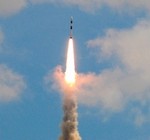On September 9, India’s space agency conducted its 100th mission, when an Indian rocket launched a French satellite.
What will India’s next 100 space missions involve? Should India focus on building fleets of satellites, sending probes to the moon and Mars, or human space flight? Perhaps all of them. An optimal space strategy will focus on a mix of economic, scientific, and strategic missions.
Since 1975, India’s space agency has built 62 satellites and 38 rockets. It initially constructed light rockets that could only lift small 50kg to100 kg scientific satellites to low-earth-orbit (LEO); none of these had significant military or economic capabilities. In the mid-1990s, however, it began launching the more powerful Polar Satellite Launch Vehicle (PSLV). It subsequently developed the even more powerful Geostationary Satellite Launch Vehicle (GSLV)—which uses the PSLV’s first two stages and has a cryogenic engine, initially built by Russia and now built by India, in its third stage.
The reliable PSLV, which has had 21 consecutive successful flights, can carry 1 tonne earth observation satellites to LEO. Images from these satellites have found useful economic applications in areas ranging from agricultural and environmental monitoring to geology and urban planning. The less successful GSLV, which has failed four of its seven flights, can carry 4 tonne payloads to LEO or 2 tonne communication satellites to the required higher Geostationary Earth Orbit (Orbit). Its successor, the GSLV Mark 3, will be able to lift 4 tonne communication satellites, capable of carrying a larger number of transponders and facilitating a greater volume of communications, to GEO. It can alternatively lift an 8 tonne payload to LEO. Until the GSLV and GSLV Mark 3 are proven, however, India’s space agency will launch some of its communications satellites aboard foreign launchers such as European Ariane rockets—it has done this six times in the past decade.
In recent years, on a budget of $1 billion to $1.5 billion, India’s space program has annually conducted two to three space launches. Assuming that the budget increases modestly each year, it can conduct four launches annually over the next five years, and five or more annually in the following five years. Thus, over the next decade, India can launch about 50 satellites or other payloads on Indian rockets and perhaps 15 satellites on foreign launchers. India can make optimal use of these space assets by allocating some 10%-15% of the Indian launches toward strategic military applications; another 10-15% for scientific and developmental missions; the remaining 70-80% for economic applications; and most of the foreign launches for economic applications.
The end result of these more than 100 space missions would be a formidable space force. India can then have a fleet of five to 10 dedicated military satellites—one or two each for its army, navy and air force, and one to two for a nuclear command authority. Its PSLV can launch 4 to 5 scientific payloads, such as an astronomy satellite and probes to the moon and Mars. India can work to perfect its GSLV so that it can then reliably carry 2 tonne communication satellites to GEO or a 4 tonne space capsule to LEO (India’s space agency has conceptualized such space capsules that carry astronauts into space). It can conduct one or two developmental flights of the GSLV Mark 3, so that, after a few additional test flights, it is available for launching 4 tonne communication satellites to GEO, or a larger 8 tonne space capsule (similar in weight to China’s space capsules) to LEO. India can continue to launch a few satellites for international clients. And it will have about 50 satellites catering to various sectors of its own economy—perhaps 10 for a regional navigational network; 15 – 20 for earth observation; a few for meteorological missions; and 15 – 20 more for communications and other purposes.
Four other developments can significantly augment India’s space efforts.
First, India can build up the ground segment of its space program to make optimal use of the data acquired from its space assets.
Second, it can transfer many of its proven space launch and satellite projects to the private sector, which already manufactures and fabricates the key components for India’s rockets and satellites.
Third, it can continue its international collaboration endeavors.
Fourth, it can begin looking toward its 200th to 300th space missions. Most of these will still focus on economic, strategic, and scientific applications—they will essentially involve replacing the satellites launched in the 100th to 200th missions that will retire after five to ten years of operation. Yet other missions can explore new frontiers such as alternative launch vehicles, a space plane which is presently in a prototype phase, and space capsules for a manned space program. Such a mix of missions will have important national and international ramifications—they will enable India’s space agency to fulfill its original mandate of applying high-technology toward the advancement of India’s economy, and they will affirm India’s status as one of the world’s six major space powers.
Dinshaw Mistry is associate professor at the University of Cincinnati. He specializes in nuclear, missile, and space technology, and is author of ‘Containing Missile Proliferation.’
This article was exclusively written for Gateway House: Indian Council on Global Relations. You can read more exclusive content here.
For interview requests with the author, or for permission to republish, please contact outreach@gatewayhouse.in.
© Copyright 2012 Gateway House: Indian Council on Global Relations. All rights reserved. Any unauthorized copying or reproduction is strictly prohibited.


